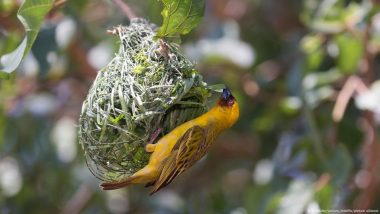Animals are remarkable architects. Their nests, tunnel systems, and caves are perfectly designed. Some of their structures are thousands of years old. Here are just a few examples of their inventive constructions.A cozy love nest for the beloved
For a romantic date, male Asian bowerbirds build a pergola out of grass and twigs. They also decorate their "terrace" with colorful flowers, berries, or mushrooms. If the female bird likes it and they mate, a nest is built for laying eggs. The young birds are then hatched there.
Also Read | India News | Diwali: Jaipur Police Makes Special Security Arrangments.
Weaving, braiding, knotting
Weaver birds, like these village weavers in Uganda, impress females with an airy nursery. The entrance is located at the bottom of the cleverly interwoven nests, protecting the young from nest predators. To prevent the eggs or chicks from falling out, and to let the parents breed in peace, a slanted entrance tunnel is added to the nest.
Dedicated flat share
Sociable weavers in Namibia are also weaver birds — they build communal nests with up to 90 breeding and "living rooms." If these nests, weighing up to a ton, don't collapse, these giant shared homes are used for decades. The community provides protection from heat, cold, and nest predators. Occasionally, some breeding spaces are rented out to other bird species.
A leaf nest made with spit and combined efforts
Unlike many ant species, Asian weaver ants build their nests in trees. They weave and glue leaves together until they form a spherical structure. Even the smallest ants contribute to this communal work: a secretion from ant larvae serves as glue to hold the nest together. "Only together are we strong" is the universal motto of ants.
An ecological megacity built for millennia
Some termite hills reach over ten meters (about 33 feet) high and extend 30 meters underground, including sophisticated air shafts. A mixture of feces, saliva, and soil makes these structures extremely durable. The oldest inhabited termite hills in South Africa are 34,000 years old. Termites also improve the fertility of the soil and make it more drought-resistant. Termites are cockroaches by the way, not ants.
Spider silk is stronger than steel
Few materials combine as many superpowers as spider web threads. Spiders produce the silk in special glands. Spider silk is thinner than a human hair but stronger than a steel cable and can withstand temperatures of up to 200 degrees Celsius- (392 degrees Fahrenheit). By the way, only the anchor threads and spiral threads of the web are sticky — the non-sticky ones are for moving around and not getting stuck in the web.
Lightweight nests
The nests of paper wasps last only one season. The insects chew wood fibers into a kind of paper pulp and build their honeycomb nest from it. When it gets too warm, wasps sit on the outside of the open combs and fan cool air inside. Although the nests are easy to destroy, they can be rebuilt almost anywhere with little effort. A significant evolutionary advantage for this species.
Bumblebees live in abandoned places
Bumblebees use abandoned mouse holes, large piles of deadwood, or rock crevices to build their nests. This makes it easier for the fertilized young queen, the only survivor of a swarm through the winter. In a suitable old structure, she can lay her eggs in spring without wasting energy on building efforts. After a few weeks, the young bumblebees hatch.
A protective underground city
Prairie dogs dig extensive tunnel systems and chambers where thousands, sometimes even millions, of animals can live. These structures offer protection in the vast grasslands of North America, are perfectly climate-controlled, and are even protected from floods by earth mounds. Guards are posted at the entrances to warn their family with a whistle when danger approaches.
Coral reefs: Megacities in the sea
In terms of size, coral reefs are the largest living structures. A single coral polyp is only about one centimeter in size, but each one has an external skeleton made of calcium. Together, their colonies form massive structures in the ocean, home to thousands of species. The Great Barrier Reef in Australia, over 2300 km long, is the largest in the world.
This article was adapted from German.
(The above story first appeared on LatestLY on Oct 30, 2024 05:10 PM IST. For more news and updates on politics, world, sports, entertainment and lifestyle, log on to our website latestly.com).













 Quickly
Quickly




















